The bradford reagent recipe is a simple and commonly used method for protein quantification, utilizing the coomassie brilliant blue dye. With just a few ingredients including coomassie brilliant blue g-250, phosphoric acid, and methanol, the bradford reagent can accurately determine protein concentration.

Credit: accmultimedia.austincc.edu
The Importance Of Bradford Reagent In Protein Quantification
The bradford reagent is an essential tool for protein quantification. By using this reagent, scientists can accurately measure the protein concentration in a sample. Traditional protein quantification methods often face various challenges. They can be time-consuming, costly, and less precise.
However, the bradford reagent offers a reliable and convenient solution. Its principle is based on the binding of the dye to proteins, resulting in a color change. This color change can be measured using a spectrophotometer, allowing for precise quantification.
With the introduction of the bradford reagent, protein quantification has become more efficient and accurate. Scientists can now easily determine the protein concentration in their samples, aiding in various research fields such as biochemistry and molecular biology. The significance of protein quantification cannot be underestimated, as it provides valuable insights into protein expression levels and enables further analysis and experimentation.
Understanding The Bradford Reagent
The bradford reagent is an essential tool for measuring protein concentration in various scientific applications. Its composition consists of a dye that undergoes a color change in the presence of proteins. Unlike other methods, the bradford reagent offers several advantages.
It provides a wide linear range and is compatible with various protein samples. Additionally, its sensitivity and accuracy make it a preferred choice among researchers. When using the bradford reagent, a protein sample is mixed with the reagent, resulting in a color change that can be quantified using spectrophotometry.
This method is quick, easy to perform, and has become a standard in protein analysis. Researchers rely on the bradford reagent for its reliability and efficiency in obtaining accurate protein concentration measurements.
Bradford Reagent Recipe: Ingredients And Preparation
The bradford reagent recipe is a commonly used chemical solution in biochemical assays. To prepare this reagent, you will need specific components, a step-by-step guide, and tips for handling and storing it. The components required for the bradford reagent include methanol, coomassie brilliant blue g-250 dye, phosphoric acid, and concentrated sulfuric acid.
The step-by-step guide for preparing the bradford reagent involves adding the components in a specific order and mixing them thoroughly. It is important to handle the reagent with caution, wearing appropriate protective gear and avoiding contact with skin or eyes.
Storing the bradford reagent in a cool, dark place is crucial to maintain its effectiveness. By following these guidelines and procedures, you can successfully prepare and utilize the bradford reagent in your biochemical experiments.
Procedure For Protein Quantification Using Bradford Reagent
Protein quantification using the bradford reagent is a reliable and commonly used method. Following a detailed protocol, start by preparing the bradford reagent according to the established recipe. Next, mix the protein sample with the reagent and allow them to react for a specific time.
Measure the absorbance of the resulting solution using a spectrophotometer. Troubleshooting common issues is essential to ensure accurate results. Some challenges may include background interference, inappropriate protein concentration, or inaccurate pipetting. To address such issues, always perform appropriate controls and calibrate equipment beforehand.
Additionally, ensure the sample is well-solubilized and free from contaminants. Maintaining consistent assay conditions and practicing careful pipetting techniques are also crucial. By adhering to these guidelines, researchers can effectively quantify protein using the bradford reagent, facilitating various scientific experiments and discoveries.
Advantages And Limitations Of Bradford Reagent
The bradford reagent offers several advantages for protein quantification. It provides a simple and rapid method, suitable for a wide range of protein concentrations. The bradford assay is also compatible with a variety of buffers and detergents. Additionally, the reagent has high sensitivity and can detect as little as 1-20 micrograms of protein.
Its ability to measure both soluble and insoluble proteins makes it versatile. However, there are limitations and challenges associated with the bradford assay. It requires a standard curve for accurate quantification and can be affected by interfering substances. Compared to other protein quantification methods, such as the lowry assay and bca assay, the bradford reagent is cost-effective and does not require a heating step.
Overall, the bradford reagent offers numerous benefits with some limitations and is a valuable tool for protein quantification.
Applications Of Bradford Reagent In Research And Industry
The bradford reagent is widely used in research and industry due to its versatility and accuracy. Various fields of study, such as biology, biochemistry, and molecular biology, have employed the bradford assay for protein quantification. It has been utilized in research studies to determine protein concentrations and analyze protein-protein interactions.
In addition, the bradford reagent finds extensive applications in the industrial sector. It is used for protein determination in various industries, including food, pharmaceuticals, and biotechnology. By accurately measuring protein concentrations, the bradford reagent assists in quality control and optimization of production processes.
It is an essential tool in protein analysis, providing reliable and rapid results. Researchers and industry professionals continue to rely on the bradford reagent for its efficiency and effectiveness in protein quantification.
Best Practices For Achieving Accurate Protein Quantification
Achieving accurate protein quantification is crucial for reliable research results. There are several factors that can affect the accuracy of protein quantification. To optimize the bradford assay protocol, consider these recommendations. First and foremost, avoid starting sentences with commonly overused phrases.
Keep your sentences brief, with a maximum of 20 words each. This will make your content more seo friendly and easier to understand. Additionally, vary your sentence beginnings to maintain reader interest. By doing so, you’ll create unique and engaging content.
Remember to write in active voice, as it helps improve readability. Following these guidelines will help you write a compelling blog post on the bradford reagent recipe.
Future Developments In Protein Quantification Techniques
Advancements in protein quantification technology are paving the way for future developments in the bradford reagent recipe. Researchers are actively exploring potential improvements to the reagent and assay, aiming to enhance accuracy and sensitivity. These improvements are driven by emerging trends in protein quantification research, which push for more efficient and reliable techniques.
With the integration of cutting-edge technology, protein quantification methods are continuously evolving to meet the demands of the scientific community. By staying up-to-date with these advancements, researchers can attain more accurate and reproducible results in their protein analysis experiments. The ongoing efforts to refine the bradford reagent recipe will greatly contribute to the field of protein quantification and aid in the exploration of complex biological processes.
Frequently Asked Questions Of Bradford Reagent Recipe
What Is The Bradford Reagent Used For?
The bradford reagent is used in protein quantification assays to determine the concentration of proteins in a given sample. It works by measuring the absorbance of a dye that binds to proteins, providing a quick and accurate method for protein analysis.
How Does The Bradford Reagent Work?
The bradford reagent works by utilizing a coomassie brilliant blue dye that changes color in the presence of proteins. The dye binds to the amino acids in proteins, resulting in a shift in absorbance that can be measured spectrophotometrically. This allows for the quantification of protein concentration in a sample.
What Are The Advantages Of Using The Bradford Reagent?
The bradford reagent offers several advantages in protein quantification. It provides a simple and rapid method, requiring only a small amount of sample. It has a broad dynamic range and is compatible with a wide range of protein concentrations. Additionally, it does not require a separate step for protein precipitation, saving time and effort.
How Do I Prepare The Bradford Reagent?
To prepare the bradford reagent, mix coomassie brilliant blue g-250 dye with a solution of phosphoric acid, methanol, and water in specified quantities. Allow the mixture to cool before use. It is important to follow the recipe accurately to ensure accurate protein quantification results.
Can The Bradford Reagent Be Used With Different Types Of Samples?
Yes, the bradford reagent can be used with various types of samples, including purified proteins, cell lysates, and crude protein extracts. However, it is important to note that different sample types may require different dilutions or adjustments in the bradford reagent protocol for accurate protein quantification.
Are There Any Limitations Of Using The Bradford Reagent?
While the bradford reagent is a widely used and reliable method for protein quantification, there are some limitations to consider. It may not be suitable for certain protein classes or samples containing interfering substances. Additionally, accurate calibration using protein standards is crucial for obtaining accurate results.
It is always recommended to validate the method with other techniques for confirmation.
Conclusion
To sum up, the bradford reagent recipe is a crucial tool for protein quantification and analysis in research and scientific fields. Its simplicity, accuracy, and reliability make it a go-to choice for researchers worldwide. By using the correct ingredients and following the proper procedure, one can easily prepare this reagent in their lab without any hassle.
The bradford method, utilizing this reagent, offers a rapid and cost-effective solution for protein quantitation. Moreover, the compatible nature of the bradford reagent with various protein assays and spectrophotometers enhances its versatility and usability. It provides accurate and consistent results, enabling researchers to gather vital information about protein concentrations in their samples.
By employing the bradford reagent in their experiments, scientists can advance their understanding of cellular processes, disease mechanisms, and drug development. Embracing this reliable protein quantitation technique can undoubtedly contribute to making significant strides in the field of scientific research.

